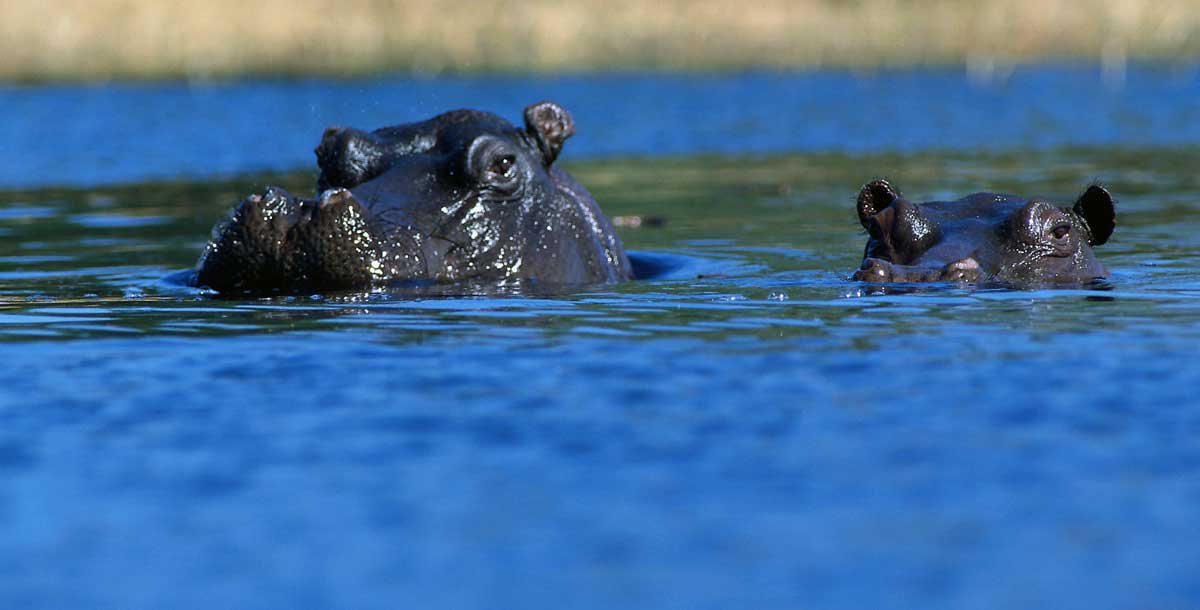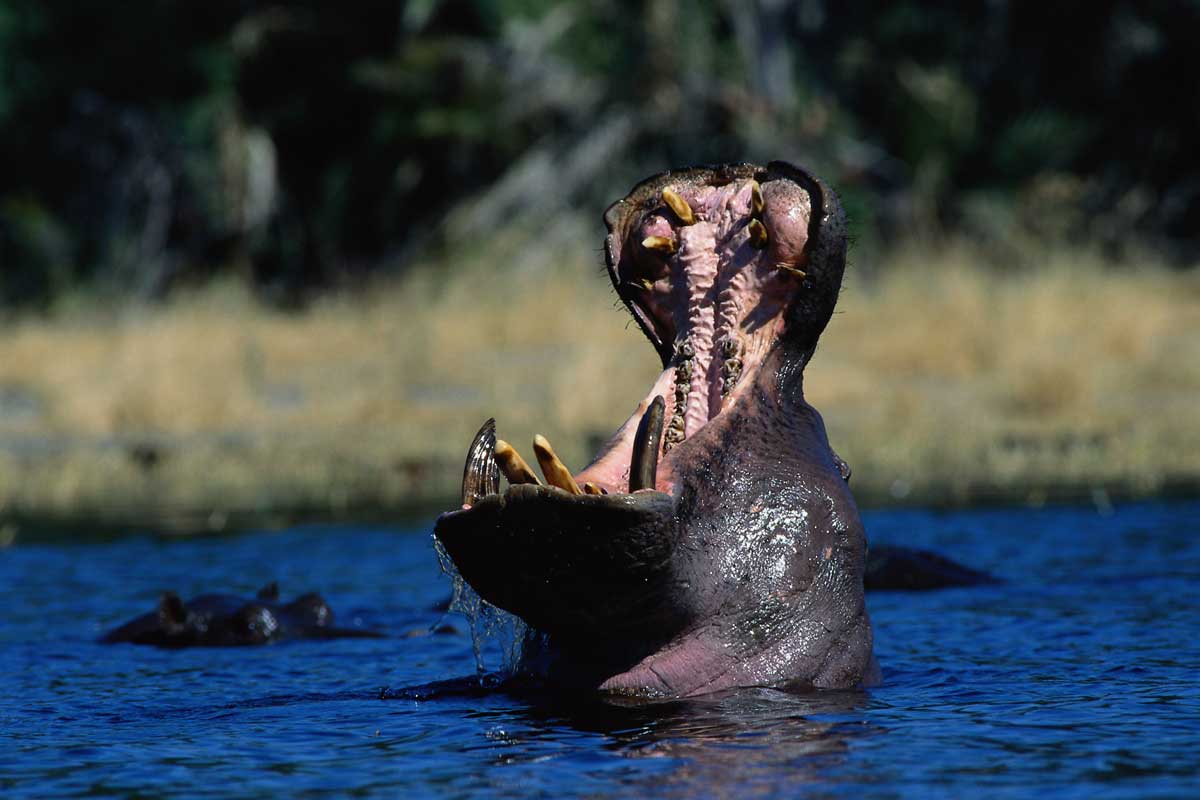Crossbow Hippo
 Late October, 2014: The post on the SCI Record Book Official Facebook Page read, “Outstanding entries in the department today! First ever SCI documented hippopotamus taken with a crossbow….” This announcement was the culmination of more than a year’s preparation for my hunt in the famous Luangwa River valley of Zambia.
Late October, 2014: The post on the SCI Record Book Official Facebook Page read, “Outstanding entries in the department today! First ever SCI documented hippopotamus taken with a crossbow….” This announcement was the culmination of more than a year’s preparation for my hunt in the famous Luangwa River valley of Zambia.
Peter Hathaway Capstick popularized that area of Africa in his many books. For this hunt, Capstick‚Äôs book about the great killers of the African bush Death in the Long Grass, offered a chapter that was especially poignant. Luangwa‚Äôs hippos are the antithesis of the Hollywood hippo popularized by Walt Disney. Hippos kill more people in Africa than any other animal, and the Luangwa River has more hippo than all of the rest of Africa. Capstick‚Äôs opening story in Chapter 5, ‚ÄúHippo,‚Äù has him shooting a hippo with a .470 Nitro Express double rifle. On my hunt, though, I would be carrying a crossbow–in particular, a Kodabow ‚ÄúDangerous Game‚Äù crossbow designed and built specifically for this hippo hunt by Chuck Matasic and his team at Kodabow.
After some very successful crossbow hunts together at the beautiful Mumembe Ranch in Mkushi, Zambia, PH William M. Drummond suggested that we organize a hippo hunt with a crossbow in the Luangwa river valley of Zambia. With his suggestion in mind, I began planning what I would need to take a hippo with a crossbow.
The archer is particularly mindful of the thickness through the chest of the animal(s) being hunted. The same bow/arrow combination used for whitetail deer, for instance, might not be appropriate for an animal that is thicker through the chest area, such as elk or moose. The hippo is thicker through the chest (about four feet through the heart/lung area) than any other animal, including an elephant. A rhino has similar dimensions and, while elephants are much taller, they are not extremely thick through the heart/lung area when compared to the hippo, which is barrel shaped in that area–and a rather large barrel, at that! Another concern for the archer is the thickness and density of the hide. The hide of a hippo is about one to 1-1/2-inches thick and feels like a truck tire; surprisingly hard and tough for an animal that spends most of its time in the water.
After a review of my existing data, and reading the writings of people who build broadheads, arrows and bows, I determined that, at a minimum, I wanted an arrow of at least 1,000 grains, preferably 1,250 grains, that delivered at least 130 foot/pounds of kinetic energy and/or a momentum of 1.0 slug/feet/second, or more. The “Dangerous Game” crossbow that Kodabow built produces 153 ft./lbs. of kinetic energy and 1.3 slug/ft./sec. of momentum with a 1,250-grain arrow. Of course, the “Dangerous Game” crossbow also has fine machine fitting and a rock-solid dependable trigger, customary of Kodabow crossbows.
My final choice for hippo crossbow arrows were 22-inch, 1,250-grain, double carbon shafted arrows that sport 315-grain forged stainless steel broadheads. William assured me that if we scheduled a hunt in the hot dry season, we could get within 40 yards of a hippo; therefore, it was up to me to build accurate arrows and practice so that I could make any reasonable shot we might encounter.
After four days of frustration, we saw a shadow in the water slightly downstream, indicating that another hippo was approaching, invading the territory of the two bulls we were watching. Hippos are violently territorial, so both bulls turned to face the intruder, which put both of them sideways to me. Now if they would just stand up and separate! Both bulls alternately began to bob up and down in what seemed to be an intimidation tactic — not rising out of the water high enough to offer a shot and then submerging completely. It was very exasperating! When the intruder approached still closer, the bull closest to me; the one that we thought was the larger of the two, stood up and took a step forward to challenge the intruder. As he stood up and advanced, he had his ears pinned back and his chin tucked down in what seemed to be a head-butting aggressive or combative stance. His combative advance not only positioned him ahead of the other bull, which cleared an exit path for my shot, but by standing he also provided enough vertical exposure for me to hit him with a high lung shot.
At the shot, he lunged forward, went underwater and proceeded approximately 75 yards downstream to a pod of about 30 hippos in the river. It was absolutely amazing how quickly he moved underwater! There was underwater turmoil in, under and around the pod, intensely upsetting the pod. After much grumbling and splashing, the pod began to settle down. At first, I thought that the arrowed hippo was seeking refuge in their midst. However, he did something that I had not anticipated; he came back to his previous position in the river in front of me! He again faced downstream and rose up in a sort of bravado gesture to the intruder he had driven back into the pod. It occurred to me that he was not running from my shot as much as he was charging the intruder and chasing the intruder out of his territory. With that done, he returned to his territory and rose up to show the intruder who was “boss.”
 In that bravado stance, though, he rose up out of the water higher than before and high enough for me to get a second shot; a quartering-away heart-lung shot at 36 yards. At the second shot, he violently lunged forward again and proceeded underwater, looking like a diving submarine; raising the surface of the water over him and creating a wave behind that was large enough to surf. This time, he did not stop at the pod; he kept going until he got to shallow water beyond the pool. After a couple of rolls and some thrashing, he expired on his left side, leaving the first arrow sticking up in the air like a flagpole. And so, in less than four minutes from the first shot, all was quiet on the Luangwa again.
In that bravado stance, though, he rose up out of the water higher than before and high enough for me to get a second shot; a quartering-away heart-lung shot at 36 yards. At the second shot, he violently lunged forward again and proceeded underwater, looking like a diving submarine; raising the surface of the water over him and creating a wave behind that was large enough to surf. This time, he did not stop at the pod; he kept going until he got to shallow water beyond the pool. After a couple of rolls and some thrashing, he expired on his left side, leaving the first arrow sticking up in the air like a flagpole. And so, in less than four minutes from the first shot, all was quiet on the Luangwa again.
The first shot, as it turned out, had gone through a rib on the near side–no easy task considering the size of hippo ribs–punctured high through both lungs and stuck in a rib on the far side. The arrow penetrated up to the fletching. However, with his thrashing and rolling, the hippo had dislodged the arrow from the far-side rib. The broadhead would not let the arrow come back out through the rib it had punctured on the way in, leaving it flying like that proverbial flagpole when he took his final roll.
The second shot had quartered down and forward from the point of entry behind the ribs on the hippo’s right side. It sliced through the near side lung, cut a major blood vessel near the top of the heart and punctured the far side lung. It then exited behind the shoulder on the hippo’s left side. The fletching hung up just inside the hide, leaving about six inches of arrow inside. The rest of the arrow snapped off in the rolling and thrashing, which is no easy task considering they were double-shafted carbon.
After the hippo pod settled down and returned to normal, it was time for the real work. The camp crew came out and rolled the hippo downstream to an area where the bank of the river was accessible to the truck. They built a smoking rack on the bank and kindled a fire under it to smoke the meat. While the hippo was still in the water, they began skinning and boning out the meat from the topside down, placing the meat on the smoking racks. When they got down near the water level, several men dragged the remainder of the hippo out onto the shore and continued with the task of boning out and smoking the meat.
The crew worked all night and by morning had one-half of the hippo meat processed and ready for delivery to the local Lala Ambon tribe in Chisomo village. The meat from one-half of a hippo will just about overload a Toyota 4-wheel-drive pickup. Hippo meat is very highly regarded and everyone in the village was quite excited and happy that we got a hippo. The other half of the hippo meat went to the men in the camp crew and they, too, were very happy to dine so well.
With everyone fed and happy, my job was done. Phil Minnaar, the pilot for this excursion into central Zambia, and I took off from Nyakolwe airstrip on the first leg of my trip back home. After Phil flew me to the Ndola Zambia International Airport, I boarded a flight to Johannesburg, South Africa, then on to the U.S. through Atlanta, Georgia, then to Houston, Texas, and finally to Albuquerque, New Mexico. After three days and 10,000 miles, I was home, where I completed my section of the paperwork to submit the crossbow hippo to the SCI Record Book, and start planning my next trip to Africa. No, I am not ‚Äúbat-crap crazy‚Äù–I just have Africa in my blood. Come to think of it, it might have been my wife who popularized that phrase in relation to my hippo hunt.–Jim Aken

